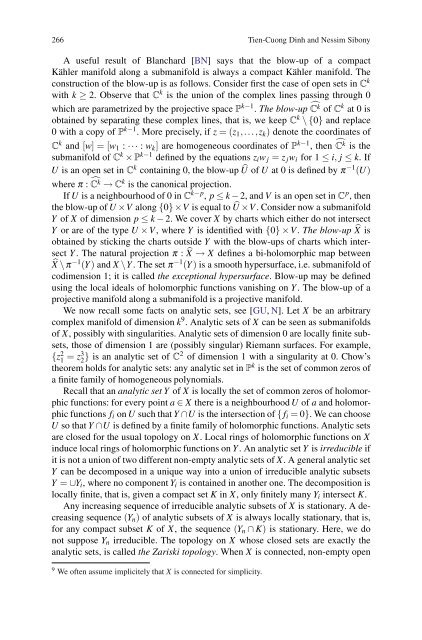Discrete Holomorphic Local Dynamical Systems
Discrete Holomorphic Local Dynamical Systems
Discrete Holomorphic Local Dynamical Systems
Create successful ePaper yourself
Turn your PDF publications into a flip-book with our unique Google optimized e-Paper software.
266 Tien-Cuong Dinh and Nessim Sibony<br />
A useful result of Blanchard [BN] says that the blow-up of a compact<br />
Kähler manifold along a submanifold is always a compact Kähler manifold. The<br />
construction of the blow-up is as follows. Consider first the case of open sets in C k<br />
with k ≥ 2. Observe that C k is the union of the complex lines passing through 0<br />
which are parametrized by the projective space P k−1 . The blow-up � C k of C k at 0 is<br />
obtained by separating these complex lines, that is, we keep C k \{0} and replace<br />
0 with a copy of P k−1 . More precisely, if z =(z1,...,zk) denote the coordinates of<br />
C k and [w] =[w1 : ··· : wk] are homogeneous coordinates of P k−1 ,then � C k is the<br />
submanifold of C k × P k−1 defined by the equations ziw j = z jwi for 1 ≤ i, j ≤ k. If<br />
U is an open set in C k containing 0, the blow-up �U of U at 0 is defined by π −1 (U)<br />
where π : � C k → C k is the canonical projection.<br />
If U is a neighbourhood of 0 in C k−p , p ≤ k − 2, and V is an open set in C p ,then<br />
the blow-up of U ×V along {0}×V is equal to �U ×V. Consider now a submanifold<br />
Y of X of dimension p ≤ k − 2. We cover X by charts which either do not intersect<br />
Y or are of the type U × V, whereY is identified with {0}×V. The blow-up �X is<br />
obtained by sticking the charts outside Y with the blow-ups of charts which intersect<br />
Y . The natural projection π : �X → X defines a bi-holomorphic map between<br />
�X \π −1 (Y) and X \Y .Thesetπ −1 (Y ) is a smooth hypersurface, i.e. submanifold of<br />
codimension 1; it is called the exceptional hypersurface. Blow-up may be defined<br />
using the local ideals of holomorphic functions vanishing on Y. The blow-up of a<br />
projective manifold along a submanifold is a projective manifold.<br />
We now recall some facts on analytic sets, see [GU, N]. Let X be an arbitrary<br />
complex manifold of dimension k 9 . Analytic sets of X can be seen as submanifolds<br />
of X, possibly with singularities. Analytic sets of dimension 0 are locally finite subsets,<br />
those of dimension 1 are (possibly singular) Riemann surfaces. For example,<br />
{z 2 1 = z3 2 } is an analytic set of C2 of dimension 1 with a singularity at 0. Chow’s<br />
theorem holds for analytic sets: any analytic set in P k is the set of common zeros of<br />
a finite family of homogeneous polynomials.<br />
Recall that an analytic set Y of X is locally the set of common zeros of holomorphic<br />
functions: for every point a ∈ X there is a neighbourhood U of a and holomorphic<br />
functions fi on U such that Y ∩U is the intersection of { fi = 0}. We can choose<br />
U so that Y ∩U is defined by a finite family of holomorphic functions. Analytic sets<br />
are closed for the usual topology on X. <strong>Local</strong> rings of holomorphic functions on X<br />
induce local rings of holomorphic functions on Y. An analytic set Y is irreducible if<br />
it is not a union of two different non-empty analytic sets of X. A general analytic set<br />
Y can be decomposed in a unique way into a union of irreducible analytic subsets<br />
Y = ∪Yi, where no component Yi is contained in another one. The decomposition is<br />
locally finite, that is, given a compact set K in X, only finitely many Yi intersect K.<br />
Any increasing sequence of irreducible analytic subsets of X is stationary. A decreasing<br />
sequence (Yn) of analytic subsets of X is always locally stationary, that is,<br />
for any compact subset K of X, the sequence (Yn ∩ K) is stationary. Here, we do<br />
not suppose Yn irreducible. The topology on X whose closed sets are exactly the<br />
analytic sets, is called the Zariski topology.WhenX is connected, non-empty open<br />
9 We often assume implicitely that X is connected for simplicity.



